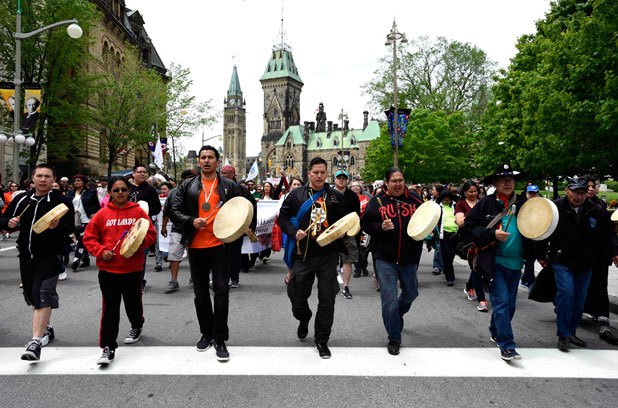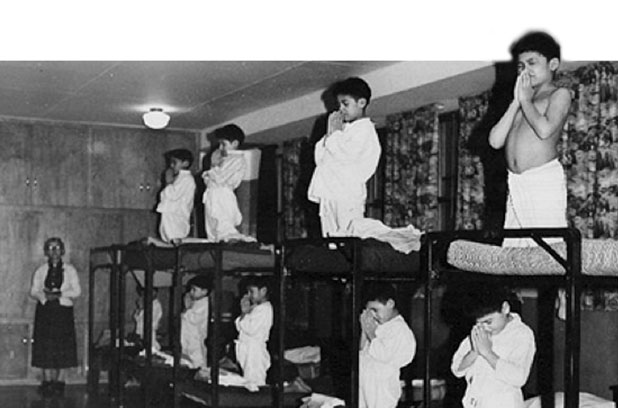Canada’s Residential Schools a History of ‘institutionalized Child Neglect’
Metro
The residential schools that removed Aboriginal children from their homes, subjecting many of them to substandard education, malnutrition, abuse, illness and even death was a key part of a government-led policy that amounted to cultural genocide, the Truth and Reconciliation Commission concludes. “These measures were part of a coherent policy to eliminate Aboriginal people as distinct peoples and to assimilate them into the Canadian mainstream against their will,” says the 381-page summary of its final report released Tuesday in Ottawa. “The Canadian government pursued this policy of cultural genocide because it wished to divest itself of its legal and financial obligations to Aboriginal people and gain control over their land and resources,” says the report. The heart-wrenching and damning report is the culmination of a six-year examination of the history and legacy of residential schools — largely operated by churches and funded by the Canadian government — that saw 150,000 First Nations, Metis and Inuit children come through their doors for more than a century. Through the testimony of residential school survivors, former staff, church and government officials and archival documents, the Truth and Reconciliation Commission pieced together a horrifying history that, despite its rippling effects, has been repeatedly dismissed or ignored. It also describes how the legacy of residential schools continues, not only through the direct effect that generations of institutionalization and abuse has had on survivors and their families, but how it is manifested in racism, systemic discrimination and poverty, as well as dying indigenous languages. “The urgent need for reconciliation runs deep in Canada,” says the report, noting relations between Aboriginal peoples and the federal government have worsened seven years after Prime Minister Stephen Harper apologized to the survivors of residential schools on behalf of Canadians. “Too many Canadians know little or nothing about the deep historical roots of these conflicts. This lack of historical knowledge has serious consequences for First Nations, Inuit, and Metis peoples, and for Canada as a whole,” says the report, which includes 94 recommendations for setting Canada on the path to reconciliation. “One hundred years from now, our children’s children and their children must know and still remember this history, because they will inherit from us the responsibility of ensuring that it never happens again,” the report says.
The summary report describes how children were often taken from their homes, sometimes without being given the chance to say goodbye to their relatives, and put on buses or trains to travel long distances, the younger ones crying as it sunk in they were leaving their parents behind. Arriving at residential school, children had their hair chopped off and their clothing removed — one survivor recalled having her beaded moccasins, made by her grandmother for her to wear to school, taken from her and thrown in the garbage. They were separated from their siblings and survivors spoke of being ignored, or even punished, for crying. “It was, at best, institutionalized child neglect,” says the report. The quality of the education was often poor: the lessons were heavy on rote memorization, the teachers were often unqualified the classrooms were overcrowded. Many of the schools operated on a “half-day system”, where students would attend classes half the day and spend the rest of their time cooking, cleaning and jobs that was justified as “vocational training” but in many cases it was really a low-cost way to operate the buildings. Students were discouraged, and often outright forbidden, from speaking their Aboriginal languages, with survivors telling of receiving the strap and having their mouths washed out with soap for speaking their maternal tongues. Sports, art and other recreational activities, despite being a source of relief and positive memories for many survivors, were chronically underfunded and they too, were often meant as a way to promote assimilation. Many schools did not provide their students with enough to eat, with one survivor describing a regular diet of boiled fish, including scales and bones, mixed up with flour. Other students recalled how a job in the staff dining room, where the leftovers of better meals were available to steal, was a coveted position. The number of children who died at residential schools may never be known, as deaths were poorly reported and records were not kept for very long, but the Commission estimates the number of reported deaths to be 3,201. Many times schools refused to cover the costs of sending bodies home to their families for burial, opting for poorly marked graves in cemeteries that were abandoned when the schools shut down. The Commission also notes that until the 1950s, Aboriginal children in their care had a much higher death rate than school-aged non-Aboriginal children, and that when the cause of death was reported, it was most often from tuberculosis. “The high death rates in the schools were, in part, a reflection of the high death rates among the Aboriginal community in general. “Indian Affairs officials often tried to portray these rates as simply the price that Aboriginal people had to pay as part of the process of becoming civilized. In reality, these rates were the price they paid for being colonized,” says the report. Survivors and archives show that discipline at the schools could be harsh and cruel, with one school locking runaways into a prison cell for a week upon their return. Former students described having their ears pulled for getting an answer wrong in class, or humiliation punishments for wetting their beds. Use of corporal punishment, such as the strap, was also common and the Commission lays much of the blame on lack of direction from the Canadian government. “The failure to develop, implement and monitor effective discipline sent an unspoken message that there were no real limits on what could be done to Aboriginal children within the walls of a residential school. The door had been opened early to an appalling level of physical and sexual abuse of students, and it remained open throughout the existence of the system,” says the report. The Commission says abuse was rampant, with nearly 38,000 survivors having submitted independent claims for injuries associated with physical or sexual abuse through the Indian Residential Schools Settlement Agreement as of this January, nearly 31,000 of them resolved and a total of $2.69 million awarded in compensation so far. These abuses were also known and covered up, even well into the 20th century, the report says. “When it came to taking action on the abuse of Aboriginal children, early on, Indian Affairs and the churches placed their own interests ahead of the children in their care and then covered up that victimization. It was cowardly behaviour,” says the report. Survivors told the Commission stories of staff watching them shower, or rubbing against them while they sat in their laps, and many told how they had been raped. “Other students recalled being assaulted in the church confessional. A student in the change room would suddenly have a bag pulled over his head. The abuse could begin with an instruction to report to the shower room in the middle of the night or to take lunch to a staff member’s room,” says the report. The report also describes how this abuse by staff “created the conditions” for bullying by fellow students, which in many cases took the form of physical and sexual abuse for which Aboriginal communities are still feeling the effects. “The betrayal by fellow students has contributed significantly to the schools’ long-term legacy of continuing division and distrust within Aboriginal communities. The residential school system’s shameful inability to protect students from such victimization, even from among themselves, represents one of its most significant and least-understood failures,” says the report. Despite the shameful history recounted in the pages of the report, the Commission also expresses its hope for a better future and urges Canadians to pick up the mantle from the residential school survivors who spoke their truths. “The Survivors acted with courage and determination. We should do no less. It is time to commit to a process of reconciliation. By establishing a new and respectful relationship, we restore what must be restored, repair what must be repaired, and return what must be returned,” says the report.
|
.
Any original material on these pages is copyright © BishopAccountability.org 2004. Reproduce freely with attribution.

